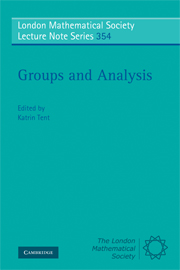Book contents
- Frontmatter
- Contents
- Preface
- List of speakers and talks
- 1 Harmonic analysis on compact symmetric spaces
- 2 Weyl, eigenfunction expansions, symmetric spaces
- 3 Weyl's work on singular Sturm–Liouville operators
- 4 From Weyl quantization to modern algebraic index theory
- 5 Sharp spectral inequalities for the Heisenberg Laplacian
- 6 Equidistribution for quadratic differentials
- 7 Weyl's law in the theory of automorphic forms
- 8 Weyl's Lemma, one of many
- 9 Analysis on foliated spaces and arithmetic geometry
- 10 Reciprocity algebras and branching
- 11 Character formulae from Hermann Weyl to the present
- 12 The Classification of affine buildings
- 13 Emmy Noether and Hermann Weyl
12 - The Classification of affine buildings
Published online by Cambridge University Press: 12 May 2010
- Frontmatter
- Contents
- Preface
- List of speakers and talks
- 1 Harmonic analysis on compact symmetric spaces
- 2 Weyl, eigenfunction expansions, symmetric spaces
- 3 Weyl's work on singular Sturm–Liouville operators
- 4 From Weyl quantization to modern algebraic index theory
- 5 Sharp spectral inequalities for the Heisenberg Laplacian
- 6 Equidistribution for quadratic differentials
- 7 Weyl's law in the theory of automorphic forms
- 8 Weyl's Lemma, one of many
- 9 Analysis on foliated spaces and arithmetic geometry
- 10 Reciprocity algebras and branching
- 11 Character formulae from Hermann Weyl to the present
- 12 The Classification of affine buildings
- 13 Emmy Noether and Hermann Weyl
Summary
Introduction
The theory of affine buildings reveals fascinating links between group theory, Euclidean geometry and number theory. In particular, reflections, the Weyl chambers of root systems and valuations of fields all play a central role in their classification.
The study of affine buildings was begun by Bruhat and Tits in [4] and the classification of affine buildings of rank at least four was completed by Tits in [11]. When combined with the classification of Moufang polygons carried out in [12], the Bruhat-Tits classification covers also affine buildings of rank three under the assumption in this case that the building at infinity is Moufang.
Our goal here is to give a very brief overview of this work. All the details can be found in the forthcoming book [14] (as well, of course, as in [4] and [11]).
In this article we regard buildings exclusively as certain edge-colored graphs. For different points of view, see [1]. Other excellent sources of results about affine buildings are [3], [5] and [8].
Buildings
Let Σ be an edge-colored graph and let I denote the set of colors appearing on the edges of Σ. We call |I| the rank of Σ. For each subset J of I let ΣJ be the graph obtained from Σ by deleting all the edges whose color is not in J (but without deleting any vertices). A J-residue of Σ for some subset J of I is a connected component of the graph ΣJ. Thus two distinct J-residues (for a fixed subset J of I) are always disjoint.
- Type
- Chapter
- Information
- Groups and AnalysisThe Legacy of Hermann Weyl, pp. 271 - 284Publisher: Cambridge University PressPrint publication year: 2008

